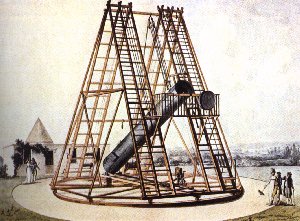
Herschel doubles the size of the Solar System
One hundred and fifty years after Galileo peered into the heavens with his small telescope, William Herschel built and observed with much larger telescopes, including the one shown here. Herschel built the largest telescope of this time, a reflector with a 1.2 meter diameter mirror.With his larger, more powerful telescopes, Herschel was able to probe deeper into space. In 1781 he discovered a new planet, now called Uranus, in an orbit round the sun, far beyond Saturn.
Herschel methodically set out to measure the extent of the Milky Way. He systematically observed and cataloged thousands of the mysterious cloud like objects or nebulae that had remained un-noticed until telescopes were turned to the sky. Further generations of astronomers eventually established the objects in his catalog were galaxies and interstellar gas clouds.
Herschel also discovered that stars emit infrared radiation.